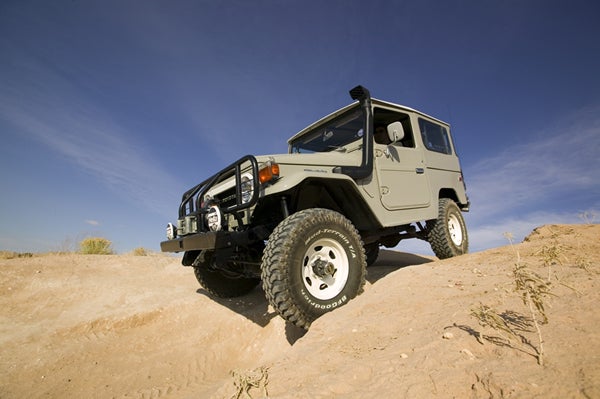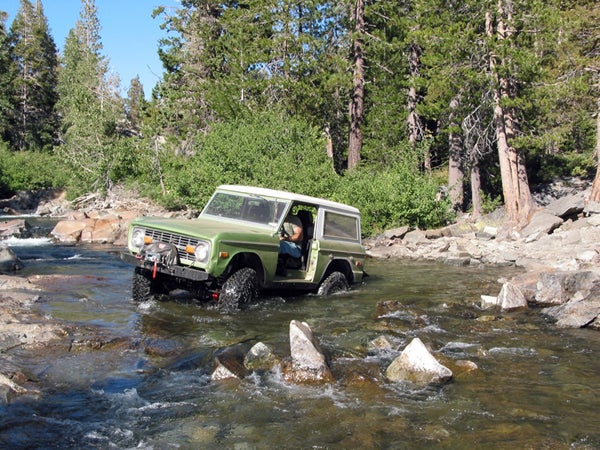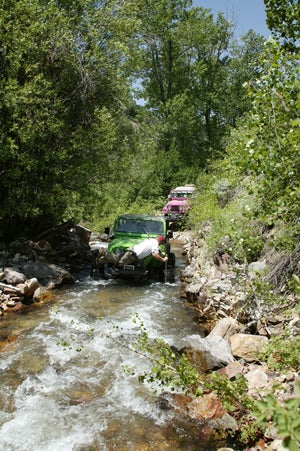![]()
If you do enough four wheeling, sooner or later you are going to have to make a water crossing. Whether it is Kane Creek in Moab, Fordyce Creek in Northern California, or a stream crossing your local trail, water is too common to avoid. Many trails follow the paths of miners and settlers who were naturally drawn to the water to power machinery, bathe, or drink from. Other trails have been entirely created by the powerful forces of water, such as the famous Surprise Canyon Trail in Southern California.
 |
Adding a snorkel doesn’t ensure that your vehicle can swim, but it is a good start. ARB Safari Snorkels are available for a wide variety of vehicle applications. |
Snorkel- The first accessory that most people think of when considering water crossings are snorkels. The premise is to raise the air intake up to a level where water cannot enter the engine. As a piston travels upward in the cylinder, it compresses the air and fuel mixture. Water, however, is not easily compressible and can lead to bent or broken rods if it enters the combustion chamber. Snorkels range from homemade PVC contraptions to vehicle-specific contoured ABS plastic models. They often require cutting a hole in the fender, so if you are adverse to modifying your sheet metal a snorkel might not be for you. There is often still room for improvement though, as many stock air intakes are relatively low and at the front of the engine bay. Moving the intake as high as possible, up against the firewall, and with a splash shield are all ways to keep water out of the engine.
Dielectric Grease- Adding a snorkel can sometimes give a false sense of security because a snorkel alone will not ensure that you vehicle will keep running when it is dunked. Your engine needs three things to keep running: air, fuel, and spark. The snorkel takes care of clean air, a sealed fuel system ensures no water enters your gasoline, but the ignition must be waterproofed as well. Dielectric grease can be liberally applied to all spark plug wires to shed water. Additionally, sealing the distributor and venting it will help to keep water out and ensure that your engine stays lit.
 |
Crossing water without doors makes it easier for water to enter the cab, but it also makes it easier for the water to drain out. |
Breathers- The distributor is not the only thing that needs to be vented. Differentials, transmissions, transfer cases, and power steering reservoirs are typically vented to the atmosphere. Most manufacturers add a check valve for a vent and send the vehicle off the assembly line. You cannot completely seal these components without blowing out seals as the air and fluid inside gearboxes expands and contracts as it heats and cools. The problem with this is that when a differential enters the water, the gear lube in the differential cools rapidly and draws in air (or water) from outside the differential. Raising the breather up to the top of the engine bay, interior, or roll cage solves the problem. Another popular solution in recent years is the “accordion” style breather that is a closed system but still allows for expansion and contraction within the gearbox.
Diesel- Want to skip the dielectric grease altogether? Diesel engines rely on combustion to ignite fuel and air, not spark. Without an ignition, spark plugs, a distributor, or spark plug wires there are a lot less components in a diesel to worry about getting wet. The increase in fuel mileage and low end torque that diesels are famous for are other great reasons to consider these engines. Did you try to cross water BEFORE reading this and get a little worse for wear? Check this out!
 |
| Probing for water depth and unseen obstacles can keep you from getting stuck, cutting a tire, or hydro-locking your engine. |
Check Ahead- When it comes time to do the deed, as it were, check the water depth beforehand. There is no point in entering five feet of water with a snorkel that is four feet off the ground. Polarized sunglasses can be useful for cutting through the surface glare of the water to see to the bottom. Also check the current in addition to the depth. The last thing you want is for your vehicle to be swept downstream. Enter the water slowly and steadily, keeping enough speed up to create a bow wave pushing in front of your vehicle. Go too slow and the water has more time to enter your vehicle, while traveling too fast can cause water to spray under the hood or even cause you to hydroplane and loose control. To combat this, some people put a tarp over the front of their vehicle to keep water from entering the engine bay.
Electric Fan- As your vehicle enters the water it is possible for the cooling fan blades to get pulled into the radiator by the stream. Installing an electric fan allows you to stop the spinning fan blades when you encounter a water crossing. Most high end fans pull as much air as mechanical fans and use a thermostat to turn on, with a manual override switch in the cab of the vehicle. If you don’t have an electric fan, remove the belt from your mechanical or clutch driven fan before entering deep water and reinstall it on the far shore once the stream crossing is complete.
Watch the Brakes- Once you have exited the other side of the water, press lightly on the brake pedal to remove any water from the brake pads and shoes. Disc brakes are much less susceptible to water issues than drums, so consider swapping out your drum brakes if you spend a lot of time in the water. Discs are also lighter, easier to maintain, and typically provide shorter stopping distances. You might need a different master cylinder if you swap in disc brakes, since they typically require a larger amount of fluid movement, but do not necessitate residual valves.
 |
Hooking up a strap before you enter the water makes it much easier to perform recovery if you get stuck or hydro-lock the engine. |
Strap Preparation- When going through deep water, you always need to plan ahead in case you do not make it all the way to the other side. Hooking up a tow strap or winch cable prior to entering the water can help to keep your clothes dry and limit the amount of time you spend in the water. Less time in the drink means less time for the water to permeate your vehicle’s mechanical components not to mention your interior.
Don’t Panic- If you do hydro-lock the engine, don’t panic. The engine will often stall before any damage is done. As noted above, water does not compress in the cylinders. Attempts to turn over an engine with water in the cylinders can result in bent rods and cracked blocks. Don’t spin the tires, as wet tires are very susceptible to cutting sidewalls. If you have a manual transmission, you don’t want to put the clutch in either, since water can enter the bellhousing between the pressure plate and clutch disk, causing them to slip.
Have a friend pull you out of the water (you do have tow hooks and a snatch strap, right?). Pull the spark plugs out, close the hood, and crank the engine over. This should remove the water from the cylinders. If the engine will not start after you re-install the spark plugs, often times some WD-40 sprayed inside the distributor cap will solve the problem.
Check Fluids- After dunking your truck make sure to check all of the fluids to make certain they did not ingest any water. Water is a poor lubricant and can wreak havoc in differentials, engines, and gear boxes. Drain any contaminated fluids into a sealed container before continuing on. It is wise to change these fluids again when you get home to ensure a long, healthy life for all bearings, synchros, clutches, and gears. Also lube any grease fittings and make sure that no water has remained captured anywhere it may cause rust. Wheel bearings and locking hubs are particularly prone to damage from stream crossings. Water is easily shed as long as it has a way out (or does not enter in the first place), but it can cause problems if it lingers.


 Your Privacy Choices
Your Privacy Choices